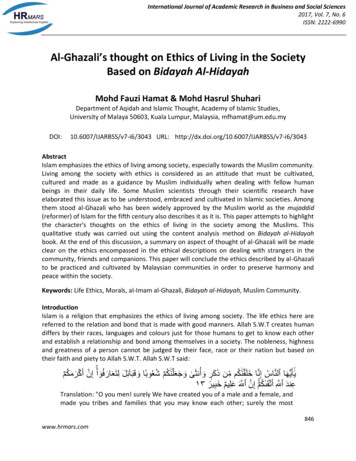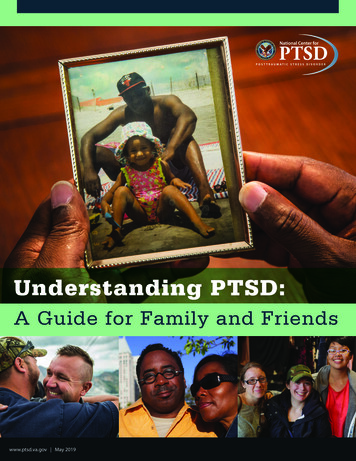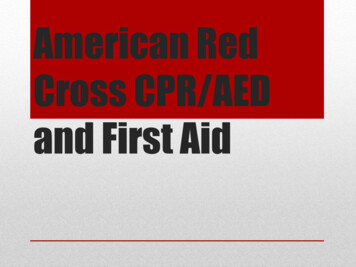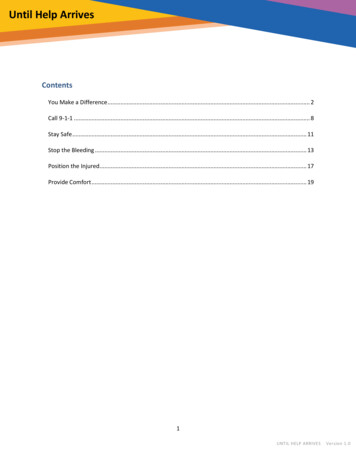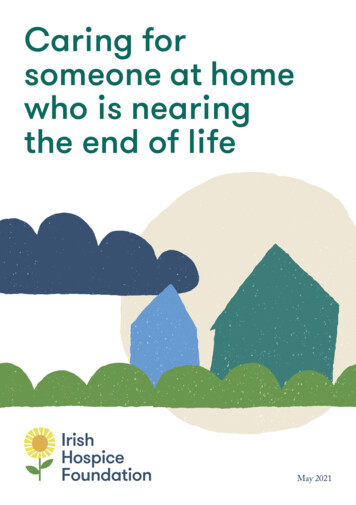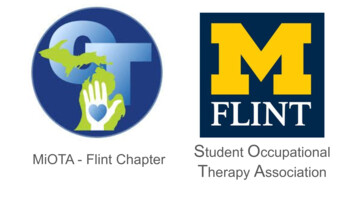
Transcription
MiOTA - Flint ChapterStudent OccupationalTherapy Association
Recognizing Danger:Understanding When Someone is in an Abusive Situation and What to DoMichelle Roldan, UM-Flint OTD StudentBarbara Haber-Grinnell, COTAL, Forensic Interviewer at Voices forChildren Advocacy CenterBen Atchison, PhD, OTR/L, FAOTA; Co-Founder, WMU Children'sTrauma Assessment Center
Terms Domestic Violence: Domestic violence is the willfulintimidation, physical assault, battery, sexual assault,and/or other abusive behavior as part of a systematicpattern of power and control perpetrated by oneintimate partner against another. It includes physicalviolence, sexual violence, psychological violence, andemotional abuse (NCADV, n.d.-14). Intimate Partner Violence: A pattern of physical,psychological, sexual, and financial harm againstcurrent or former partners (DeLany, Janet V., 2007). Sexual Harassment: Includes unwelcome sexualadvances, requests for sexual favors, and other verbalor physical harassment of a sexual nature (RAINN,2019). Sexual Assault: Sexual contact or behavior, oftenphysical, that occurs without the consent of the victim(RAINN, 2019).
Perpetrator: A person who perpetrates, orcommits, an illegal, criminal, or evil act. Victim: Used to describe individuals who arecurrently in an abusive relationship (DeLany,Janet V., 2007). Terms Cont.Survivor: Used to describe individuals who arein the abusive relationship or who haveovercome the abuse (DeLany, Janet V., 2007). Affirmative Consent: “Affirmative Consent isinformed (knowing); voluntary (freely given); and,active (not passive), meaning that, through thedemonstration of clear words or actions, aperson has indicated permission to engage inmutually agreed-upon sexual activity and theconsenting person is not incapacitated” (GrandValley State University, 2016).
National Statistics 1 in 4 women and 1 in 9 men experiencesevere intimate partner physical violence,intimate partner contact sexual violence,and/or intimate partner stalking with impactssuch as injury, fearfulness, post-traumaticstress disorder, use of victim services,contraction of sexually transmitted diseases,etc. (NCADV, n.d.-14).In the U.S., over 5.8 billions dollars is spent ondomestic violence related injuries, nearly 4.1billion is spent on direct medical and healthcare services, and 1.8 billion is spent on lossof productivity (Javaherian-Dysinger, H., et. al.,2016).47% of transgender individuals experiencesexual violence/physical violence in their lives(Human Rights Campaign, n.d.).Individuals with disabilities are 2 times morelikely to experience a violent crime, and 3 timesmore likely to experience sexual violence(NCADV, 2018).
Statistics Cont. Despite the increase in self-reports of rape and sexualassault, there was a decrease in reporting to policefrom 2017 to 2018. Forty-percent (40%) of rapes andsexual assaults were reported to police in 2017, butonly about 25% were reported to police in 2018(NSVRC, n.d.).False reporting of sexual assault is between 2-10%(NSVRC, n.d.).1 in 4 girls & 1 in 6 boys will be sexually assaultedbefore they turn 18 (YWCA, 2017).About 93% of sexually abused children know theirabuser; 10% are abused by a stranger (YWCA, 2017).Nearly 70% of all reported sexual assault occurs tochildren 17 & under (YWCA, 2017).LOCAL STATISTICS: One in three Michigan families are impacted bydomestic violence (HAVEN, n.d.).41.8% of Michigan women and 23% of Michigan menexperience intimate partner physical violence, intimatepartner rape and/or intimate partner stalking in theirlives (NCADV, n.d.-14 ).
Power and Control Wheel(NCADV)
Dynamics of AbuseRed Flags Extreme jealousy Controlling behavior/quick involvement Fixed beliefs about gender roles Possessiveness Unpredictability Bad temper Cruelty to animals Verbal abuse Gaslighting Blaming the victim for anything bad thathappens Sabotage or obstruction of the victim's abilityto work or attend school Control of what the victim wears and howthey act Demeaning the victim either privately orpublicly(NCADV, n.d.-16)
What To Look ForSigns of Abuse Physical Appearance: Various stages of injuries/healing Bruising, cuts, scars, burns,broken/sprained areas, etc. Unseasonal Clothing Clothing that hides Restricting clothing fromsurvivor(Lang, M., 2020)Mood: Feel isolated Feel depressed Feel helpless Be embarrassed of their situation Feel guilt related to the relationship Feel shame Have anxiety Have suicidal thoughts Abuse alcohol or drugs Self Harming Behaviors(NCADV, n.d.-16)
What To Look ForCont.Signs of Abuse Isolation: Withdrawn Deny or minimize the abuse or makeexcuses for the abuser Distance themselves from family orfriends Have no support from friends orfamily Feel like they have nowhere to go orno ability to get away(NCADV, n.d.-16)Hyperarousal: Extremely anxiousJumpy from minimal sounds, touch,etc.Seem preoccupied or “out of touchwith reality”/ “day dreaming”Seem impulsive or aggressive(Lang, M., 2020)
What To Look For Elder Abuse Neglect: Withholding food, water, clothing,shelter, medications, etc. Failure to ensure personal hygieneor provision of physical aids (ie:walkers, hearing aids, glasses,dentures, etc.) Failure to ensure personalsafety/medical follow upsEmotional Abuse: Verbal berating, harassment, orintimidation Threats of punishment ordeprivation Treating individual like an infant Isolating individual from others(American College of Surgeons, n.d.)
What To Look For Child Abuse Physical Abuse Appears frightened of caregiver Ex: flinches, shys away Has burns, bites, broken bones, bruises,black eyes, or complains of pain Caregiver offers no explanation of child’sinjuries Blame on child’s behaviorSexual Abuse: Attaches quickly to strangers or new adultsin their environment Demonstrates unusual sexual knowledge orbehavior given their age Difficulty walking or sitting Self Harming BehaviorEmotional Abuse: Extreme behaviors Overly aggressive to overly compliant Appears emotionally unattached tocaregiver Caregiver consistently blames, belittles, orberates child/refuses to help(Voices For Children Advocacy Center, n.d.)
Risk factors of patients whomay be trafficked include: What To Look ForSex Trafficking (Administration for Children and Families, n.d.)Minor presents without legalguardianUnstable housing situationRunaway youthSubstance useMultiple or frequent sexuallytransmitted infectionsDelay in seeking medical care (ie:no prenatal care)Children with a history of beingin the child welfare systemLGBTQ youthHistory of child abuse or familyviolenceHistory of dating violence orsexual assault(American College of Surgeons, n.d.)
Barriers To LeavingEconomic Dependence: Abuser might control all the finances Sabotage or obstruction of the victim'sability to work or attend school Lack of housingLack of Support/Resources: Have no support from friends offamily Feel like they have nowhere to go orno ability to get away Fear they will not be able to supportthemselves after they escape theabuser Have had unsupportive experienceswith friends, family, employers, lawenforcement, courts, child protectiveservices, etc. and believe they won'tget help if they leave or fearretribution if they do (e.g. they fearlosing custody of their children to theabuser)(NCADV, n.d.-17)
Barriers To LeavingCont. Fear: Fear of cultural, community, orsocietal backlash that may hinderescape or support Fear that the abuser's actions willbecome more violent and maybecome lethal if the victim attempts toleave. Fear of losing custody of any childrenif they leave or divorce their abuser orfear the abuser will hurt, or even kill,their children Fear that homelessness may be theironly option if they leave Fear judgement or stigmatization iftheir reveal the abuseEmotional Component: Hopeful that their abuser will changeand/or stop the abuse Still love their abuser Want the abuse to end, but not therelationship(NCADV, n.d.-17)
Barriers To LeavingCont.Miscellaneous: Deny or minimize the abuse ormake excuses for the abuser The rationalization of the victim thattheir abuser's behavior is caused bystress, alcohol, problems at work,unemployment, or other factors. Societal factors around women Not enough shelters to keep victimssafe. Despite the issuing of a restrainingorder, there is little to prevent areleased abuser from returning andrepeating abuse. Reluctance by prosecutors toprosecute cases. Dissuasion by police of the victimfiling charges.(NCADV, n.d.-17)
Resilience has seen a 66% increase inshelter requests since the Stay atHome order(Szatkowski, A., 2020) Relevance -for-covid-19-response Stress and social isolation can raisethe risk of domestic violence.Hurricane Harvey and Effects on FamilyViolence Survivors-- Josephine V.(Abramson, A., 2020)Serrata, PhD. Higher rates of both domesticviolence and child abuse beforeAND after the hurricane Reduced access to resources Increased stressed (via job lossor strained finances) Disconnection from socialsupport(Serrata, J. & Hurtado Alvarado, M., 2019)
ForensicInterviewing:Through An OT LensBarbara Haber-Grinnell, COTAL Application to OT: Therapeutic Use of Self Mental health aspect of OT Assessments Like a Standardized Assessment Have to remain neutral Avoid too muchpraise/feedback Observation skills Putting the pieces together Holistic Following the “script” andprocedures(Haber-Grinnell, B., 2020)
Currently, OTs are not considered mandatoryreporters LOBBY! Inclusion in Michigan House BillNo. 4108Anyone can report if you are suspicious ofabuseWhat Can We Do? Mandated 39-73971 7119 50648 44443---,00.htmlVoices for Children Advocacy CenterKalita McClure: (810)238-3333 Ext. 208kalita@voicesforcac.orgAdult Abuse:(American College of Surgeons, n.d.)Report to Adult Protective Services (APS)Child abuse and CPS: Report onlineCall the hotline Have to fill out a DHHS 3200 andfax to CPS within 72 hoursEncourage and support the adultsurvivor to file with CPS Less likely to be charged Less likely to have child removed(Lang, M., 2020)
4 Basic Components ofTrauma-Informed Care What Can We Do?Cont. Understanding the impact of traumaon individualsKnowing how trauma may affectpatients, families, and staffUtilizing knowledge about traumaresponses and putting it into practicePreventing re-traumatization(American College of Surgeons, n.d.)Screening andsvscreening.pdfScreening Areas Elder AbuseIntimate Partner Violence/SexTraffickingACEs and ResilienceCTAC Trauma Screening
Screening Elder Abuse(American College of Surgeons, n.d.)
MISC. SCREENINGGeriatric Injury Documentation Tool (GERI-IDT)(American College of Surgeons, n.d.)
Screening IPV/Sex TraffickingScreening for Intimate Partner Violence or Sexual Trafficking(American College of Surgeons, n.d.)Emergency Department Mistreatment Assessment Tool forSocial Workers (ED-MATS), Comprehensive Assessment
Screening ACEs and ResilienceACEs Info/ACE.pdfACEs onsequences-of-childhood/collection nce Questionnaire:https://www.aap.org/en-us/ layouts/15/WopiFrame.aspx?sourcedoc /en-us/Documents/RESILIENCE Questionnaire-1.docx&action default
Screening CTAC Trauma Screening(Henry, Black-Pond & Richardson, 2016)(Richardson, et. al., 2011)
CTAC Caregiver Forms and Testing Material(Richardson, et. al., 2011)(Henry, Black-Pond & Richardson, 2016)
Screening CTAC AdultsCTAC urces-0
What Can We Do?Cont.Safety Planninghttp://www.ncdsv.org/images/DV Safety Plan.pdfhttp://www.dvrc-or.org/safety-planning/A personalized, practical planthat includes ways to remainsafe while in a relationship,planning to leave, or after youleave. During Violent IncidentWhen Preparing to LeaveIn Own ResidenceWith a PPOOn the Job/In PublicDrug or Alcohol UseEmotional HealthItems to Take When Leaving(National Domestic Violence Hotline, 2020)
What Can We Do?Cont.SUPPORT(American College of Surgeons, n.d.) Listen, Believe, Empower, ReferExpress safetyReinforce the strengths of the survivor Support in decision makingRefer to propper resourcesAnd if they’re not ready to leave? Empower individuals Client knows themselves/situation best Explore why they aren’t ready to leave Explore the relationship Explore Options Communication Based! DV/SV Education Identify unhealthy dynamics Safety planning Plug resources(Lang, M., 2020)
Tough Cases:Secondary TraumaticStress andCompassion Fatigue Secondary Traumatic Stress: The emotionaldistress that results when an individual hearsabout the traumatic experiences of someoneelse or is involved in the care of traumaticallyinjured individuals Compassion Fatigue: refers to work-relatedposttraumatic stress syndrome (PTSS) thatarises from long-term exposure to otherpersons experiencing trauma. Burnout: refers to a combination ofsymptoms including emotional exhaustion,depersonalization, and a diminished sense ofpersonal accomplishment or workplacesatisfaction.(American College of Surgeons, n.d.)
Tough Cases: WaysTo Handle STS andCompassion FatigueIndividual Prevention: Life balanceRelaxation techniquesCreative expressionAssertiveness trainingCognitive restructuringTime managementPlan for copingIndividual Treatment: Focus on self careJournalingProfessional supportSupport groupsLearning new self-care strategiesReach out, ask for help!(Secondary Traumatic Stress, n.d.)
Tough Cases: WaysTo Handle STS andCompassion FatigueCont.Barbara Haber-Grinnell Work trainings and opportunitiesOutlets for self care Physical activity Hobbies Spiritual practices Etc.Support systems
Victim/Survivor ResourcesNational Hotlines/Resources Michigan Hotlines/ResourcesIPV National Domestic Violence Hotline: 1-800-799-7233Rape Abuse & Incest National Network (RAINN) Hotline:1-800-656-4673 Futures Without Violence: http://www.futureswithoutviolence.org/ National Coalition Against Domestic Violence:http://www.ncadv.org/ National Network to End Domestic Violence: http://www.nnedv.org/ National Resouces Cneter on Domestic Violence:http://www.nrcdv.org/ Office on Violence Against Women (U.S. Department of Justice): http://www.usdoj.gov/ovwElder Abuse National Center on Elder Abuse: https://ncea.acl.gov/Human Trafficking National Human Trafficking Hotlines: 1-888-373-7888 Text: 233733 Website: https://humantraffickinghotline.org/ The Polaris Project: https://polarisproject.org/resources/ One More icking/?fbclid IwAR3EjRLpjd0NBd1ybw4RthlxjI4XXy s XWHSRYx9mD-Ra7-Kk 6m7tOEi4 Rahab Ministries: http://rahab-ministries.orgIPV Michigan Coalition Against Domestic and SexualViolence Hotline: 192-29941 30586 240---,00.htmlChild Abuse lid IwAR1qwXrGyC-4Hc wjry6DzPOkwkBr6ZrPKJzo5HACz1k9B70-pQTjTpTuHEElder Abuse Michigan Department of Health & Human Services(MDHHS) Adult Protective Services: 855-444-3911 2917 92157---,00.html Elder Abuse Task Force: 855-444-3911Human Trafficking Night Angels:https://www.nightangelsdetroit.com/?fbclid LhV-fc3pBU0
A SPECIAL THANK YOU!!Barbara Haber-Grinnell, COTAL, Forensic Interviewer at Voices for Children Advocacy Center (ServingGenesee and Shiawassee Counties)Ben Atchison, PhD, OTR/L, FAOTA; Co-Founder, WMU Children's Trauma Assessment Center; Professorand Chair Emeritus at Western Michigan University; Consultant-OTD Program at the University ofMichigan-FlintMegan Lang, Crisis Intervention Advocate at Resilience: Advocates for Ending ViolenceWendy Tremaine, Ph.D., OTR/L; Academic Fieldwork Coordinator; Clinical Assistant Professor ofOccupational Therapy at the University of Michigan - FlintJillian Woodworth, DrOT, OTR/L; Clinical Assistant Professor of Occupational Therapy at theUniversity of Michigan - FlintDonna Case, Ph.D., OTL; Assistant Professor of Occupational Therapy at the University of Michigan - Flint
Contact Information Michelle Roldan:roldan@umich.eduBen Atchison:beat@umich.eduBarb Haber-Grinnell:barb@voicesforcac.org
bramson, A. (2020, April 8). How COVID-19 may increase domestic violence and child abuse. Retrieved April 23, 2020, iolence-child-abuseAdministration from Children and Families. (n.d). Resources: identifying and interacting with victims of human trafficking. Retrieved April 26, 2020, r/tips for identifying and helping victims of human trafficking.pdfAmerican College of Surgeons. (n.d.). Acs child trauma quality programs best practices guidelines for trauma center of recognition: child abuse, elder abuse, andintimate partner violence. (2019, November). Retrieved April 9, 2020, grams/trauma/tqip/abuse guidelines.ashxAtchison, B. (2020, April 23). Personal interview.DeLany, Janet V, DEd,O.T.R./L., F.A.O.T.A. (2007). Occupational therapy services for individuals who have experienced domestic violence (statement).The American Journal of Occupational Therapy, 61(6), 704-9. t.61.6.704Grand Valley State University. (2016, August 25). Retrieved April 7, 2020, from rinnell, B. (2020, April 24). Personal interview.HAVEN. (n.d.) Education and Prevention: Domestic Violence Facts:. Retrieved November 24, 2019, tion/problem.Henry, J., Black-Pond C., , & Richardson M. (2016).CTAC Trauma Screening Checklist: Identifying Children at Risk. Western Michigan University SouthwestMichigan Children’s Trauma Assessment Center (CTAC).Human Rights Campaign. (n.d.). Sexual Assault and the LGBTQ Community. Retrieved April 8, 2020, nd-the-lgbt-communityJavaherian-Dysinger, H., Krpalek, D., Huecker, E., Hewitt, L., Cabrera, M., Brown, C., . . . Server, S. (2016). Occupational needs and goals of survivors ofdomestic violence.Occupational Therapy in Health Care, 30(2), 175-186. doi:10.3109/07380577.2015.1109741Lang, M. (2020, April 8). Personal interview.National Domestic Violence Hotline. (2020, March 13). Staying Safe During COVID-19. Retrieved April 23, 2020, safe-during-covid-19/NCADV: National Coalition Against Domestic Violence. (n.d.). Retrieved November 24, 2019, from https://ncadv.org/statistics.NCADV: National Coalition Against Domestic Violence. (2018, March 13). Retrieved April 8, 2020, -and-people-with-disabilitiesNCADV: National Coalition Against Domestic Violence. (n.d.). Retrieved April 8, 2020, from https://ncadv.org/dynamics-of-abuse
References Cont.17.18.19.20.21.22.23.24.25.26.27.NCADV: National Coalition Against Domestic Violence. (n.d.). Retrieved April 16, 2020, from https://ncadv.org/why-do-victims-stayNSVRC: National Sexual Violence Resource Center. Statistics. (n.d.). Retrieved April 8, 2020, from https://www.nsvrc.org/statisticsOh, D. L., Jerman, P., Purewal Boparai, S. K., Koita, K., Briner, S., Bucci, M., & Harris, N. B. (2018). Review of tools for measuring exposure to adversity inchildren and adolescents. Journal of Pediatric Health Care, 32(6), 564-583. doi:10.1016/j.pedhc.2018.04.021RAINN. (n.d.). Sexual Harassment. Retrieved April 8, 2020, from INN: Scope of the Problem: Statistics. (2019). Retrieved November 25, 2019, from hardson, M., Black-Pond, C., Sloane, M., Atchison, B., Hyter, J., Henry, J. (2011). Neurodevelopmental Impact of Child Trauma. In P. Clements and S.Seedat (Eds). Mental Health Issues of Child Maltreatment. STM Learning, Inc.Secondary Traumatic Stress. (n.d.). Retrieved April 24, 2020, from raumatic-stressSerrata, J. V., & Hurtado Alvarado, M. G. (2019, August). Understanding the Impact of Hurricane Harvey on Family Violence Survivors in Texas and ThoseWho Serve Them. Retrieved April 23, 2020, 619.pdfSzatkowski, A. (2020, April 14). West Michigan domestic violence cases increase during COVID-19 outbreak. Retrieved April 15, 2020, ing-covid-19-outbreak?fbclid IwAR32CGq8m6w0OQx 0t5p2EVcjH2ebdV6727PLWfYXkxZGek-MRdL26URrzIVoices For Children Advocacy Center. (n.d.). Reporting Abuse COVID-19 Crisis Resource All of Us.pdf. (n.d.). Retrieved April 9, 2020, n7MhskT0s0qoPFpRp O/viewYWCA. (2017, September). Child Sexual Abuse Facts. Retrieved April 27, 2020, A-Fact-Sheet-Final.pdf
pattern of power and control perpetrated by one intimate partner against another. It includes physical violence, sexual violence, psychological violence, and emotional abuse (NCADV, n.d.-14). Intimate Partner Violence: A pattern of physical, psychological, sexual, and financial harm against current or former partners (DeLany, Janet V., 2007).


